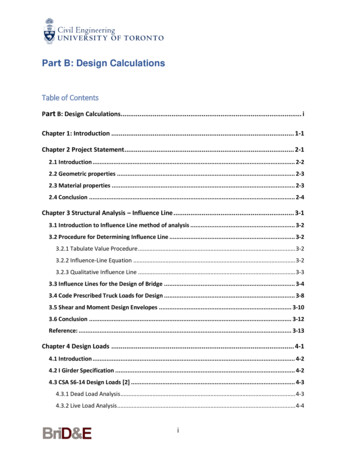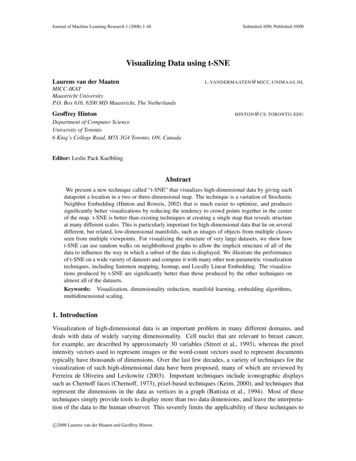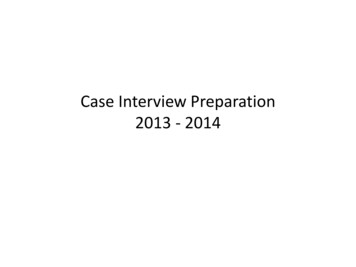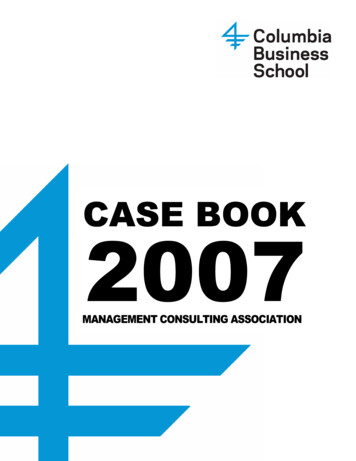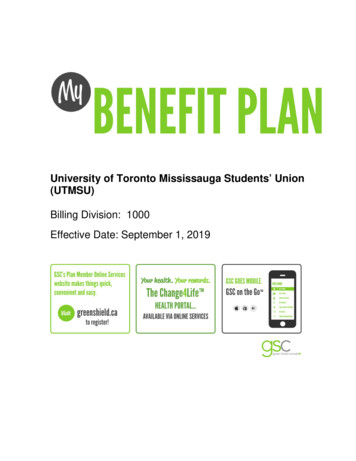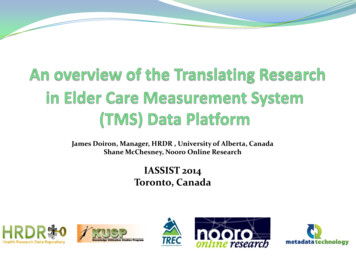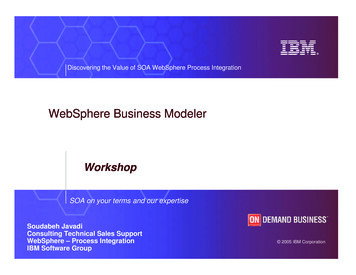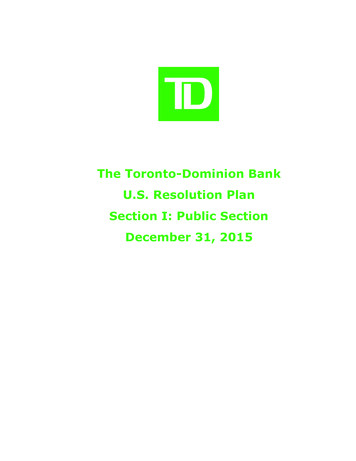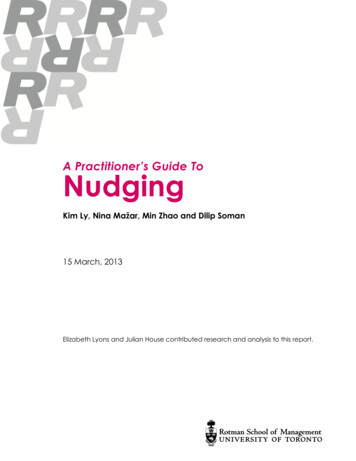
Transcription
A Practitioner’s Guide ToNudgingKim Ly, Nina Mažar, Min Zhao and Dilip Soman15 March, 2013Elizabeth Lyons and Julian House contributed research and analysis to this report.
Research Report SeriesBehavioural Economics in ActionRotman School of ManagementUniversity of TorontoROTMAN SCHOOL OF MANAGEMENT2
Correspondence and AcknowledgementsFor questions and enquiries, please contact:Professor Dilip SomanRotman School of ManagementUniversity of Toronto105 St. George StreetToronto, ON M5S 3E6Email: dilip.soman@rotman.utoronto.caPhone Number: (416) 946-0195This report is inspired by the work of Richard Thaler and Cass Sunstein. We thankLiam Delaney, Marc-Andre Pigeon and Richard Thaler for comments on previousdrafts.We also thank Kelly Peters (BEworks Inc.), Chris Duvinage, John Ginter, CarmenHo, Christine Heeah Lim, Poornima Vinoo and Leslie Wong for ideas and input. Allerrors are our own.ROTMAN SCHOOL OF MANAGEMENT3
TABLE OF CONTENTS1. Nudging: An Introduction . 52. Nudging: An Organizing Framework . 73. Nudging: Case Studies . 94. Nudging: A Guide to the Process . 154.1. Map the Context. 154.2. Select the Nudge . 164.3. Identify the Levers for Nudging . 194.4. Design and Iterate . 195. Conclusion . 21References . 22Appendices . 25ROTMAN SCHOOL OF MANAGEMENT4
1. NUDGING: AN INTRODUCTIONNudge:“to seek the attention of by a push of the elbow.to prod lightly. urge into action.” Merriam-webster.comNudge: Improving Decisions about Health, Wealth, and Happiness is the title of a 2008book written by Professors Richard Thaler and Cass Sunstein1. The book introduces thenotion of choice architecture and draws on findings from behavioural economics.Consider two cafeterias that want tohelp students consume less junk food.One cafeteria decides to attack theproblem by placing a “tax” on junkfoods or by banning the sale of junkfoods altogether2. The other cafeteriadecides to change their food displayso that junk foods will less likely be chosen. Junk foods will be placed onhigher, harder-to-reach shelves whilehealthy foods will be placed at eyelevel and within arm’s reach. Bothcafeterias are trying to influence thebehaviour but are using two entirelydifferent methods. The first cafeteria is influencing behaviour by either financially incentivizing students to choose healthier options or restricting their options and thus,their freedom of choice altogether3. The second cafeteria does neither but uses anudging strategy:“A nudge is any aspect of the choice architecture that alters people’s behaviour in apredictable way without forbidding any options or significantly changing their economic consequences. To count as a mere nudge, the intervention must be easy andcheap to avoid. Nudges are not mandates. Putting fruit at eye level [to attract attention and hence increase likelihood of getting chosen] counts as a nudge. Banningjunk food does not.” 4Research in behavioural economics has shown that changes in the environment disproportionately influence behaviour. Rather than placing restrictions or changingeconomic incentives, nudges influence behaviour by changing the way choices arepresented in the environment. While a significant change in economic outcome orincentives is not a nudge, a nudge may serve to highlight an economic incentive.ROTMAN SCHOOL OF MANAGEMENT5
For instance, members of a gym may be nudged to exercise more frequently byframing their 600 annual membership fee as 50 a month or approximately 12 aweek.Many people support the idea of organ donations but fail to follow through with theirintentions. In many countries, potential donors need to sign up to be an organ donorat the department of vehicles and licensing, but the burden of asking for the formsto indicate that choice rests with the potential donor. In a “prompted choice” system, applicants for licenses are actively asked whether they would like to donateorgans. This simple nudge has increased organ donation rates from 38% to 60% in theU.S. state of Illinois5. Another example of a nudge involves the compromise effect.When presented with three different options that vary with quality and price, mostindividuals will pick the middle option. Therefore, if a wine company would like to sellmore of a particular brand of wine, they can surround the wine with higher-end andlower-end options to increase sales of the particular brand.Both of these examples show that changes in the environment or context can influence behaviour without significantly changing financial incentives or restricting freedom of choice. Indeed, a recent paper by Chetty and colleagues in the domain ofretirement savings compares a nudging strategy (automatic contributions) with amore active incentive (tax subsidies) and concludes that the former is significantlymore effective than the latter6.In this report, we use the term “nudging” to mean a deliberate change in choice architecture with the goal of engineering a particular outcome. This report is notmeant to add to the rich discussion in Thaler and Sunstein’s book (and elsewhere) onthe appropriateness of nudging, its philosophy, and its pros and cons relative to other methods of inducing behavioural change (e.g., persuasion, economic incentives).Recent papers by Cass Sunstein and the U.K Cabinet Office in collaboration with theInstitute for Government provide a framework for understanding and cataloguingthe principles of psychology that underlie nudges. A second report by the CabinetOffice provides guidance on how to use randomized controlled trials in assessing theeffectiveness of nudges. We have summarized and referenced these three excellentresources in Appendix 1.The goal of this report is to add to and complement these resources by:1. Providing an organizational framework that identifies dimensions along whichnudging approaches could be categorized.2. Presenting a number of short case studies.3. Giving the practitioner (the choice architect) some process guidelines onhow to develop a nudge (or a program that comprises of multiple nudges).ROTMAN SCHOOL OF MANAGEMENT6
2. NUDGING: AN ORGANIZING FRAMEWORKFrom slight changes in text to new product innovations, nudges vary widely in termsof implementation and characteristics7. Regardless of the method or medium usedfor implementation, nudges share characteristics that can be classified across fourdifferent dimensions:1.2.3.4.Boosting Self-Control vs. Activating a Desired Behaviour.Externally-Imposed vs. Self-Imposed.Mindful vs. Mindless.Encourage vs. Discourage.The first dimension looks at whether a nudge is designed to boost self-control andhelp individuals follow through with a decision (such as contributing to a retirementplan). With certain behaviours, such as saving money or exercising, there is a discrepancy between what people would like to do and what people end up doing.Nudges that help boost self-control will correct for this discrepancy. In other domainssuch as littering, individuals might not always actively consider what the right behaviour should be. In this case, nudges are designed to activate a desired behaviour ornorm and influence a decision that an individual is indifferent or inattentive to. Thesebehaviours are not at the top-of-mind for the majority of people; hence people areunlikely to impose nudges that influence these behaviours upon themselves. Therefore, nudges that seek to activate latent or non-existent behavioural standards inpeople rely on exposing them to conditions in which those standards become moresalient.The second dimension considers whether a nudge will be voluntarily adopted. Selfimposed nudges are voluntarily adopted by people who wish to enact a behavioural standard that they feel is important. Such nudges may include using products,such as the well-known Save More Tomorrow Program8, or practices such as voluntarily asking for a reduction on one’s credit limit. Externally-imposed nudges do notrequire people to voluntarily seek them out. Rather they passively shape behaviourbecause of the way they present available options without constraining them.The third dimension considers whether a nudge will guide the individual to take amore cognitive, deliberate approach to decision-making and remove some of theeffects of the often unconscious behavioural influences present in the context; orwhether it will guide them towards a more automatic, implicit approach that utilizeswell-established behavioural influences or heuristics. Mindful nudges guide individualstowards a more controlled state and help people follow through with a behaviouralstandard that they would like to accomplish but have trouble enacting. Such nudges influence the intention to eat healthier, stop smoking, exercise and save more.Mostly, these nudges help people make better intertemporal choices so that theirbehaviour in the present better reflects their wishes for the future.ROTMAN SCHOOL OF MANAGEMENT7
Mindless nudges include the use of emotion, framing, or anchoring to sway the decisions that people make.The fourth dimension considers whether a nudge encourages or discourages behaviour. Encouraging nudges facilitate the implementation or continuation of a particular behaviour. Discouraging nudges on the other hand, hinder or prevent behaviourthat is believed to be undesirable.These four dimensions combined result in twelve different types of nudges. Table 1displays a taxonomy framework that has been developed based on the dimensionsdiscussed above and lists specific examples for each type of nudge. More comprehensive programs might have multiple “nudges” embedded in them, and hence it ispossible that these programs fall across multiple categories.Table 1. Examples of SEDSimplifying taxrules to make taxfiling easier.Placing signs toremind people not to litter.Advertisingthat mostpeople arerecycling toincrease recycling efforts.Using fakespeed bumpsto CONTROLACTIVATING A DESIREDBEHAVIOURENCOURAGEMINDLESSSimplifying application processesfor college grantsto encouragehigher-level education10.Installing cardashboardsthat trackmileage toreduce gasusage11.Automaticallyenrolling forprescriptionrefills to encourage taking medication.Placing unhealthy foodsin harder toreach places12.SELF-IMPOSEDMINDFULMaintaining anexercise routineby agreeing topay a small penalty if a gym sessionis missed13.Avoiding drunkdriving by hiring a limo service beforehand14.Joining a peersavings groupto encouragesaving money15.Channellingmoney into aseparate account to reduce the likelihood of it being spent16.ROTMAN SCHOOL OF MANAGEMENT8
NUDGING: CASE STUDIESIn this section we describe a few representative cases to illustrate how nudges havebeen used to help individuals make better decisions.1) USING DESCRIPTIVE SOCIAL NORMS TO INCREASE VOTER PARTICIPATIONImproving voter turnout is a common issue among many countries. A commonstrategy used by voting campaigns is to emphasize low voter turnout in the hopesthat it will motivate citizens to vote and make a difference. Emphasizing the opposite – that voting is a common social practice - could be a more effective strategy.The experiments conducted by Alan Gerber and Todd Rogers compared the effects of both strategies on voter intention during the 2005 New Jersey and 2006California elections. A phone campaign was developed using two sets of telephone scripts – one emphasizing that voter turnout was expected to be low (lowturnout-script), and another emphasizing that voter turnout was expected to behigh (high turnout-script). After listening to the script, respondents were asked howlikely they were to vote in the upcoming election.The results showed that the high turnout-script increased the likelihood of receivinga 100% likely to vote response by 7%. In addition, researchers found that the highturnout-script was most effective on respondents who were occasional and infrequent voters.17MINDFULENCOURAGEDISCOURAGEACTIVATINGA F-IMPOSEDROTMAN SCHOOL OF MANAGEMENT9
2) A NUDGE TO THE GARBAGE BINLittering is a problem for many cities. While many people know theharmful effects of littering, they still continue to litter. In Copenhagen for example, it is estimated that 1 in 3 individuals will occasionally litter. To resolve this problem, a research team from Roskilde University tested a nudge to help pedestrians avoid littering.The team placed green footprints that led to various garbage binsin the city and handed out caramels to nearby pedestrians. Afterhanding out the caramels, they observed how many pedestrianswould follow the footprints to the garbage bin and dispose of thecaramel wrapper. The results showed that there was a 46% decrease in caramel wrappers littering the streets when the greenfootprints were in use.18MINDFULENCOURAGEDISCOURAGEACTIVATINGA F-IMPOSE
turnout-script), and another emphasizing that voter turnout was expected to be high (high turnout-script). After listening to the script, respondents were asked how likely they were to vote in the upcoming election. The results showed that the high turnout-script increased the likelihood of receiving a 100% likely to vote response by 7%. In addition, researchers found that the high turnout .
